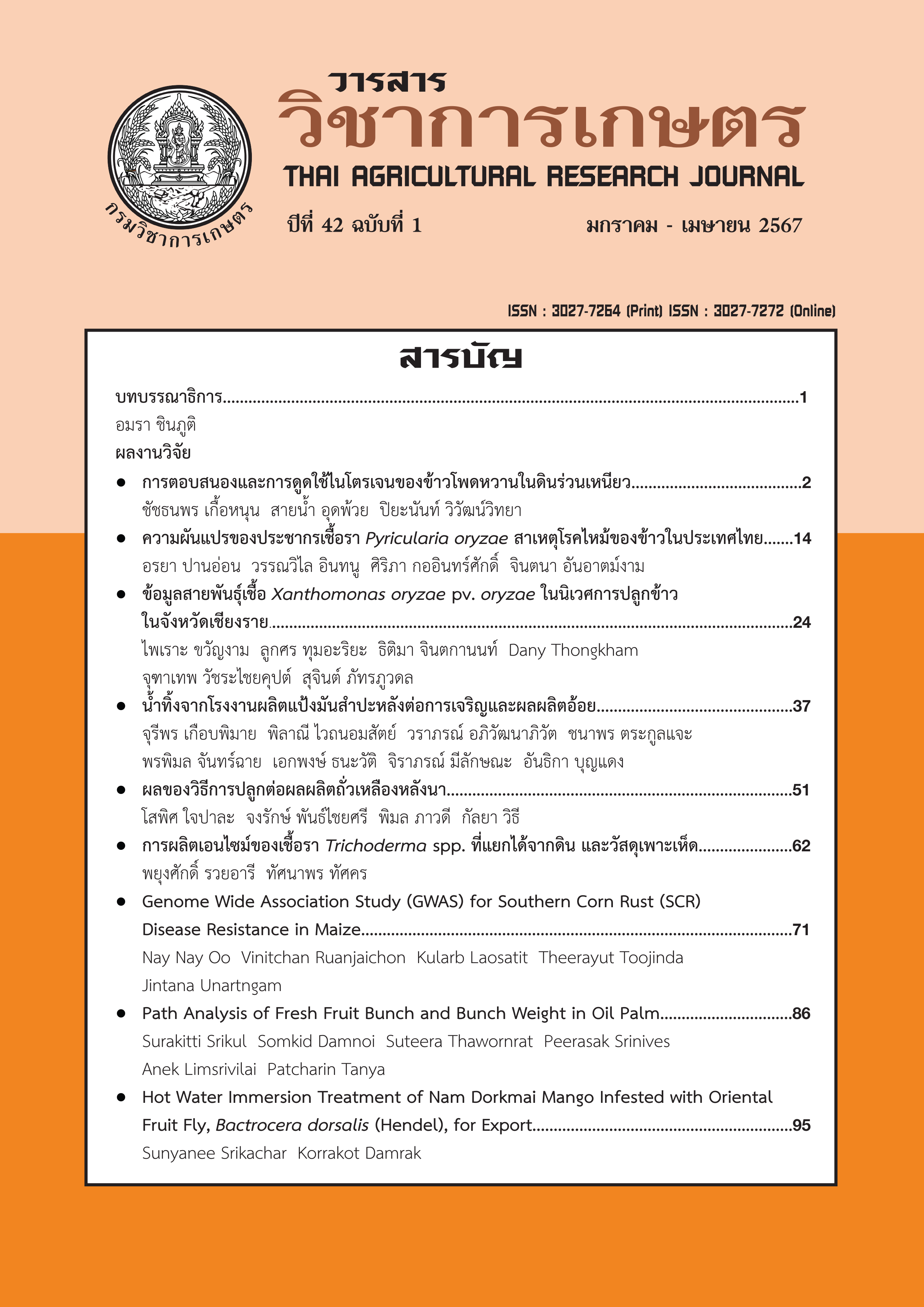ผลของวิธีการปลูกต่อผลผลิตถั่วเหลืองหลังนา
DOI:
https://doi.org/10.14456/thaidoa-agres.2024.5คำสำคัญ:
ถั่วเหลือง, วิธีการปลูก, ถั่วเหลืองหลังข้าว, พันธุ์เชียงใหม่ 60บทคัดย่อ
การปลูกถั่วเหลืองในฤดูแล้งส่วนใหญ่จะปลูกในเขตชลประทาน เป็นการปลูกในนาหลังจากเก็บเกี่ยวข้าว และมีวิธีการปลูกที่หลากหลาย ที่เหมาะสมกับการเตรียมแปลงของแต่ละพื้น การทดลองนี้มีวัตถุประสงค์เพื่อศึกษาหาวิธีการปลูกถั่วเหลืองหลังนาที่เหมาะสมให้ผลผลิตสูง และคุ้มค่าต่อการลงทุนมากที่สุด ดำเนินการทดลองในฤดูแล้ง ปี พ.ศ. 2561-2563 ที่ศูนย์วิจัยพืชไร่เชียงใหม่ โดยใช้ถั่วเหลืองพันธุ์เชียงใหม่ 60 วางแผนการทดลองแบบสุ่มในบล็อกสมบูรณ์ จำนวน 4 ซ้ำ 6 กรรมวิธี ดังนี้ 1) ปลูกแบบกระทุ้งปลูก (วิธีแนะนำ) 2) ปลูกแบบใช้ล้อจิก 3) ปลูกแบบหว่าน 4) ปลูกแบบกระทุ้งปลูกร่วมกับการคลุมฟาง 5) ปลูกแบบใช้ล้อจิกร่วมกับการคลุมฟาง 6) ปลูกแบบหว่านร่วมกับการคลุมฟาง ผลการทดลองจากการวิเคราะห์ข้อมูลรวม 3 ปี พบว่า วิธีการปลูกถั่วเหลืองหลังนาที่แตกต่างกันทำให้การเจริญเติบโต และผลผลิตมีความแตกต่างกันอย่างมีนัยสำคัญทางสถิติ การปลูกแบบกระทุ้งร่วมกับการคลุมฟาง การปลูกแบบใช้ล้อจิกร่วมกับการคลุมฟาง และการปลูกแบบหว่านร่วมกับการคลุมฟาง ให้ผลผลิตไม่แตกต่างกันทางสถิติ (447-449 กิโลกรัมต่อไร่) แต่สูงกว่าวิธีการอื่น ๆ อย่างมีนัยสำคัญทางสถิติ การเพิ่มขึ้นของผลผลิตของทั้ง 3 กรรมวิธีดังกล่าว ส่วนใหญ่เป็นผลมาจากการเพิ่มขึ้นอย่างมีนัยสำคัญของจำนวนฝักต่อต้น ขณะที่จำนวนเมล็ดต่อฝัก และขนาดเมล็ด ไม่มีการเปลี่ยนแปลงมากนัก และทุกกรรมวิธีมีอัตราส่วนผลประโยชน์ต่อต้นทุน อยู่ระหว่าง 1.06 – 1.66 จึงถือว่าคุ้มค่าต่อการลงทุน โดยการปลูกแบบหว่านร่วมกับการคลุมฟาง เป็นกรรมวิธีที่มีความคุ้มค่าต่อการลงทุนมากที่สุด
เอกสารอ้างอิง
กรมวิชาการเกษตร. 2545. เกษตรดีที่เหมาะสมสำหรับถั่วเหลือง. โรงพิมพ์ชุมนุมสหกรณ์การเกษตรแห่งประเทศไทย จำกัด กรุงเทพฯ. 26 หน้า.
จงรักษ์ พันธุ์ไชยศรี. 2561. การเตรียมดินและการปลูกถั่วเหลือง. หน้า 12-15. ใน: เอกสารประกอบการฝึกอบรมการผลิตถั่วเหลือง. 15-17 พฤศจิกายน 2561, เชียงใหม่.
เฉลิมพล แซมเพชร. 2542. สรีรวิทยาพืชไร่. โรงพิมพ์นพบุรีการพิมพ์, เชียงใหม่. 276 หน้า.
ชูชีพ พิพัฒน์ศิถี. 2540. เศรษฐศาสตร์การวิเคราะห์โครงการ. กรุงเทพมหานคร: ภาควิชาเศรษฐศาสตร์, มหาวิทยาลัยเกษตรศาสตร์. 230 หน้า.
เธียรชัย อารยางกูร. 2541. ทางเลือก: ลดต้นทุนการผลิตถั่วเหลือง. ศูนย์วิจัยพืชไร่เชียงใหม่, เชียงใหม่. 62 หน้า.
เธียรชัย อารยางกูร. 2545. การเพิ่มศักยภาพการผลิตพืชของดินโดยการใส่ปุ๋ยในระบบปลูกพืชข้าว-ถั่วเหลือง. หน้า 74-85. ใน: รายงานการสัมมนาระบบเกษตรแห่งชาติ ครั้งที่ 2: ระบบเกษตรเพื่อการจัดการทรัพยากรและพัฒนาชนบทเชิงบูรณาการ. ณ โรงแรมโฆษะ, ขอนแก่น. แหล่งข้อมูล: http://www.mcc.cmu.ac.th/Seminar/pdf/1359.pdf. สืบค้น: 12 มกราคม 2564.
นรีลักษณ์ วรรณสาย เพ็ญแข นาถไตรภพ เธียรชัย อารยางค์กูร พงศ์พันธุ์ จึงอยู่สุข อำพัน พรมศิริ และมาลี พึ่งเจริญ. 2535. ผลกระทบของการกำจัดวัชพืชในถั่วเหลืองหลังนาต่อสภาพแวดล้อมในระยะยาว. หน้า 41-49. ใน: รายงานผลการวิจัยประจำปี 2536. สถาบันวิจัยพืชไร่ กรมวิชาการเกษตร.
ภิรมย์ โสฬส จินดา ขลิบทอง และสุนันท์ สีสังข์. 2558. การผลิตถั่วเหลืองและความต้องการการส่งเสริมการเกษตรของเกษตรกรในอําเภอสวรรคโลก จังหวัดสุโขทัย. การประชุมวิชาการระดับชาติ มหาวิทยาลัยเกษตรศาสตร์ วิทยาเขตกำแพงแสน ครั้งที่ 12. 8 – 9 ธันวาคม 2558. มหาวิทยาลัยเกษตรศาสตร์. แหล่งข้อมูล: https://kukr.lib.ku.ac.th/kukr_es/KPS/search_
detail/dowload_digital_file/20002085/158847 สืบค้น: 6 มีนาคม 2567.
ยุวรัตน์ บุญเกษม และปริชาติ แสงคำเฉลียง. 2565. การวิเคราะห์ต้นทุนและผลตอบแทนจากการผลิตถั่วเหลืองฤดูแล้งในนาข้าวของเกษตรกรในจังหวัดขอนแก่น. วารสารแก่นเกษตร. 50(3): 682-689.
สถาบันวิจัยพืชไร่. 2547. ถั่วเหลือง. หน้า 73-94. ใน: เอกสารวิชาการการปลูกพืชไร่. โรงพิมพ์ชุมนุมสหกรณ์การเกษตรแห่งประเทศไทย จำกัด กรุงเทพฯ.
สมศักดิ์ อิทธิพงษ์ และรัชนี โสภา. 2541. การปลูกและการดูแลรักษาถั่วเหลือง. หน้า 23-38. ใน: เอกสารวิชาการถั่วเหลือง. หจก. ไอเดีย สแควร์. กรุงเทพฯ.
สำนักงานเศรษฐกิจการเกษตร. 2564. ถั่วเหลือง: ราคาถั่วเหลืองคละรายเดือนที่เกษตรกรขายได้ที่ไร่นา ทั้งประเทศ ปี 2540-2564. แหล่งข้อมูล: http://www.oae.go.th/assets/portals/1/files/price/monthly_price/soybeans.pdf. สืบค้น: 12 มกราคม 2564.
สำนักงานเศรษฐกิจการเกษตร. 2566. ถั่วเหลืองรวมรุ่น: เนื้อที่เพาะปลูก เนื้อที่เก็บเกี่ยว ผลผลิต และผลผลิตต่อไร่ ระดับประเทศ ภาค และจังหวัด ปีเพาะปลูก 2564/65. แหล่งข้อมูล: https://www.oae.go.th/assets/portals/1/fileups/prcaidata/
files/soybeans%2064.pdf. สืบค้น: 15 กันยายน 2566.
สุดชล วุ้นประเสริฐ. 2539. การศึกษาเทคโนโลยีการใช้น้ำอย่างประหยัด และมีประสิทธิภาพในการปลูกถั่วเหลือง. หน้า 35-41. ใน: รายงานประจำปี 2539. ศูนย์วิจัยพืชไร่เชียงใหม่ สถาบันวิจัยพืชไร่ กรมวิชาการเกษตร.
Anand, D.D., S.M. Sumarjit, L. Jamkhogin, D.N. Surbala and S.N. Gopimohan. 2020. Effect of mulching on growth and yield of soybean (Glycine max (L.) Merrill). International Journal of Current Microbiology and Applied Sciences. 9(9): 3313-3318.
Hisani, W. and G.S. Kaimuddin. 2015. Increasing the Production of soybean (Glycine Max L.) by using mulch of rice straw and applying POC (liquid organic fertilizer) from seaweed (Gracilaria sp.) and cattle’s urine. Journal of Biology, Agriculture and Healthcare. 5 (14): 1-7.
Kader, M.A., M. Senge, M.A. Mojid and K. Nakamura. 2017. Mulching type-induced soil moisture and temperature regimes and water use efficiency of soybean under rain-fed condition in central Japan. International Soil and Water Conservation Research. 5(4): 302-308.
ดาวน์โหลด
เผยแพร่แล้ว
รูปแบบการอ้างอิง
ฉบับ
ประเภทบทความ
สัญญาอนุญาต
ลิขสิทธิ์ (c) 2024 วารสารวิชาการเกษตร

อนุญาตภายใต้เงื่อนไข Creative Commons Attribution-NonCommercial-NoDerivatives 4.0 International License.
วารสารวิชาการเกษตร



